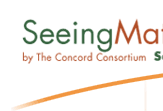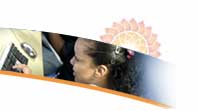         |

Seeing Math™ Secondary
 The
Seeing Math™ Secondary online professional development program focuses
on key algebra topics. The core concepts explored in each facilitated
course correspond to areas addressed by popular algebra textbooks
and align with standards established by many states and by the National
Council of Teachers of Mathematics (NCTM). The
Seeing Math™ Secondary online professional development program focuses
on key algebra topics. The core concepts explored in each facilitated
course correspond to areas addressed by popular algebra textbooks
and align with standards established by many states and by the National
Council of Teachers of Mathematics (NCTM).
The power of Seeing Math™ Secondary's learning experience goes beyond
content focus. The program's diverse blend of activities, discussion,
video and interactive software creates a dynamic learning experience
that develops content mastery complemented by pedagogical insight.
Participants emerge better equipped to help their students learn
algebra and improve academic achievement.
See our complete Features
& Benefits Chart.
| Learn
more about how the following elements enrich each Seeing Math™ learning experience:
|
Seeing
Math Secondary Process
Every Seeing Math Secondary course leads participants though a standard process that encourages participants to:
- Experience math. Course activities lead participants through some struggle — not merely to find an answer but to understand different approaches and the algebraic thinking behind them. Such struggle helps participants enter into their students' experiences of learning algebra.
- Observe and reflect. This is an effort to provide time, space, structure, and encouragement for participants to slow down the learning process. "What tools did I choose? What questions did I ask myself as I worked through the problem? What trials and errors did I make, and how did I redirect my thinking?" Observing and reflecting on one's own learning is key to understanding student thinking.
- Discuss. In the old tradition of "math class," we are supposed to figure it all out by ourselves. But a majority of math students, and math teachers, may best learn through group work and discussion. Seeing Math Secondary courses are structured for course participants to discuss their ideas and those of their peers. Colleagues often see things that they had never considered, and everyone gains a richer understanding. Indeed, with discussions encouraging varied mathematical perspectives from teachers of mathematics, participants gain appreciation for the multiple perspectives their students bring into the classroom.
- Observe and listen to student thinking. Course participants see videos of small groups of students working on the same problems the participants had worked on earlier. By examining the ways students interpret and approach problems, and by viewing supplemental specialist commentary by renowned math education experts, participants gain insights that will help them to foster fruitful discussion in your their classrooms.
- Integrate technology into the learning. Technology can affect how we learn, and even what we learn. So the appropriate use of technology is an essential skill for today's teachers of mathematics. Course participants use educational software, designed for our courses, to evaluate for themselves what learning opportunities the technology provides and how it might be integrated into classroom learning.
- Adapt material for the classroom. Course participants likely have curricula they already use in their classroom. Nonetheless, the Seeing Math Secondary courses may inspire them to try a new focus or a new approach. The courses, therefore, provide opportunities for participants to inspect their own curricula, identify areas to leverage and/or strengthen, and adapt existing material to incorporate themes from the Seeing Math Secondary courses.
Courses may count for graduate credit, continuing education units (CEUs), or professional development points (PDPs).
|

|



 The
Seeing Math™ Secondary online professional development program focuses
on key algebra topics. The core concepts explored in each facilitated
course correspond to areas addressed by popular algebra textbooks
and align with standards established by many states and by the National
Council of Teachers of Mathematics (NCTM).
The
Seeing Math™ Secondary online professional development program focuses
on key algebra topics. The core concepts explored in each facilitated
course correspond to areas addressed by popular algebra textbooks
and align with standards established by many states and by the National
Council of Teachers of Mathematics (NCTM). 